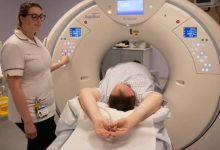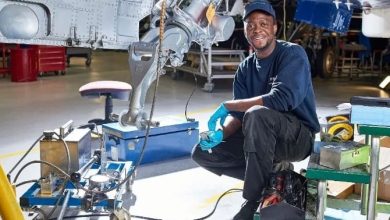
According to the Bureau of Labor Statistics, aerospace engineers in the United States earned a mean annual pay of almost $130,220 in recent years. Aerospace engineers in the middle 50 percent earned between $91,240 and $145,530 per year, with a reported median compensation of $116,500 per year. The top ten percent of aerospace engineers reported annual earnings of $166,620 or more.
Salary by Sector of Employment
As of 2019, nearly one-third of all aerospace engineers worked for aerospace parts and equipment manufacturers, earning an average yearly salary of $118,260, according to the BLS. The average compensation for aeronautical engineer employment in architectural, engineering, and related services was $121,560. The average compensation for those working in scientific research and development services was $127,800.
Salary of Aeronautical Engineers by State
According to BLS statistics from 2019, the average aeronautical engineering income differed greatly by state. Those working in the District of Columbia reported the highest mean salary by state, $140,710 per year. Maryland came in second, with an average aerospace engineer income of $135,400 per year. Texas, Colorado, and California workers reported high average salaries of $125,000 to $126,740 per year. Wisconsin had the lowest average earnings, at around $86,200 per year.
Aeronautical Engineers’ Future Prospects
According to the Bureau of Labor Statistics, employment of aerospace engineers will rise at a modest rate of 2% through 2028, resulting in an expected 1,100 new jobs. The need to increase the safety and energy efficiency of civilian airplanes and satellites is likely to drive the majority of demand for engineers in this field.
Engineers with C++ programming skills and a solid understanding of structural engineering are predicted to have the best job prospects. Obtaining a master’s degree and a license from the Accreditation Board for Engineering and Technology can help those who want to advance into managerial or supervisory jobs.
What is the definition of aeronautical engineering?
Aeronautical Engineering is the study, design, and construction of flight-capable machinery, as well as the techniques for operating airplanes. This course prepares engineers to design, build, test, and analyze commercial and military airplanes, missiles, and spacecraft. Aerospace engineers work on airplanes, spacecraft, aerospace equipment, satellites, and missiles and are responsible for their research, design, and manufacture. They also work on innovative commercial aviation, defense, and space exploration technology.
What is the role of an aeronautical engineer?
Aircraft and missiles are designed by aeronautical engineers. They research aerodynamics and apply their knowledge to guide aircraft design, building, and maintenance. They can design aircraft for commercial, government, or military usage. Aeronautical engineers, unlike aerospace engineers who develop spaceships, work with systems that operate within the Earth’s atmosphere. You would be responsible for the following as an aeronautical engineer:
For clients, designing dependable and efficient aircraft and aeronautical machines
Taking care of issues that develop throughout the aircraft’s production process
Ascertaining that your aircraft complies with all environmental and safety regulations
Examining and recommending improvements to existing aircraft
Requirements for an aeronautical engineer
Aeronautical engineering is a popular and in-demand profession. Most jurisdictions require engineers to achieve certain criteria before practicing in order to safeguard the safety of their staff and clients. The following are some of the requirements and talents required:
Education
Entry-level A bachelor’s degree in aeronautical engineering or aerospace engineering from an approved institution is normally required of aeronautical engineers. Because the degrees are so similar, many universities combine them into a double major. If you wanted to get this degree, you’d have to take math, science, physics, and chemistry classes. You’ll also take part in hands-on labs where you’ll observe and test aerodynamic theories. Depending on the school, the programs last four to five years, with some schools offering longer options that include a master’s degree.
After receiving their bachelor’s degrees, some aeronautical engineers choose to pursue full master’s degrees. Aeronautical engineers can get more knowledge and specialize in a certain area by enrolling in a master’s program.
Training
Before taking the Professional Engineer test, you must complete four years of practical training after graduation. Internships, on-the-job training, and continuing education can all be used to provide this training. Outside of the classroom, you can gain useful knowledge by observing other experts and working for several years. The purpose of your instruction throughout these years is to completely prepare you for a profession in aeronautical engineering.
Certifications
To perform engineering, all practicing engineers must receive the following licenses:
Engineering Fundamentals
Engineering students must take and pass the Fundamentals of Engineering (FE) test in their last year of study or shortly thereafter. The exam is available in seven fields, including chemical, civil, environmental, and mechanical engineering, and has 110 questions. Before you may pursue a career as a Professional Engineer, you must first obtain this qualification (PE).
Engineer (Professional)
Most employers demand that aeronautical engineers have or be qualified for their PE. After four years of work in the field of aeronautical engineering, you can take an exam to get this license. After several years of practical experience, the PE exam assesses engineers’ ability in their chosen sector. For aeronautical engineers to practice publicly, they must obtain certification.
What can you anticipate from a degree in aeronautical engineering?
Aeronautical engineering degrees are commonly referred to as BEng (Bachelor of Engineering) and MEng (Master of Engineering) (Masters in Engineering). Undergraduate aeronautical engineering degrees typically span three or four years, however many institutions allow students to move directly into a master’s degree in aeronautical engineering, lengthening the program by a year or two.
In such circumstances, BEng and MEng students attend the same courses for the first two or three years, and then continue with the BEng for one more year or graduate to the more advanced MEng for two years if they perform well enough. Some universities will enable this transfer in the first or second year of a BEng program, while others will allow post-secondary candidates to enroll in an MEng program right away. A few colleges offer associate degree programs in aeronautical engineering, although these are mainly reserved for practicing engineers who have previously graduated in a related subject and want to change fields.
Students must do coursework and laboratory activities, attend tutorials, and participate in field trips in addition to listening to lectures. With autonomous study expected in all degree programs and evaluation divided between tests and coursework assignments, group collaboration and group design work may be a feature. You may be able to attend lectures given by specialists in the aerospace sector and perhaps ride in a flight simulator, depending on the capabilities available at your selected college.
Related Post:Online Masters Programs in Biology
What are the steps to becoming an aeronautical engineer?
Obtaining employment in the aerospace sector necessitates years of study and training. The following are the measures to take:
- Get the education you require.
An approved college must grant you a four-year degree in aeronautical or aerospace engineering. Courses in mathematics, science, and physics are required for these degrees. You’ll also take part in hands-on labs where you’ll test aerodynamic theories and gain the technical knowledge you’ll need to comprehend the mechanical side of engineering. Consider pursuing a master’s degree if you wish to specialize in a certain field of engineering.
- Get a passing grade on the FE.
To become an engineer, you must take and pass the Fundamental Engineering exam after graduation. You can work as an engineer with the FE until you have enough experience to take the PE.
- Get some experience.
To become a PE, you must have worked in an engineering environment. Find a company that will train you and provide guidance till you are fully licensed.
- Get your PE by working hard.
After four years of experience in the profession, you can take the Professional Engineering exam to become a licensed engineer.
Specializations in aeronautical engineering
Aerodynamics
The interaction of bodies with the atmosphere, as well as the study of the ensuing forces and motion of objects through the atmosphere, is the focus of this subject of engineering. Aerodynamic design, compressible flow, flow control, flow measurement, power control, structural design, and fluid dynamics are all topics covered in aerodynamics.
You’ll learn how to model aerodynamics using wind tunnels and computational fluid dynamics (CFD), as well as how to build scale models and conduct flight tests. Flow control and assessment, engine and experimental aerodynamics, transonic flow, hypersonic and high-temperature gas dynamics, and launch and re-entry aerodynamics are all covered.
Engineers with specialized knowledge of fluid flow behavior will always be in demand as the search for aerodynamic refinement and performance optimization for the next generation of aircraft continues. Also, as people become more environmentally conscious, there is a greater emphasis on aerodynamic improvement in areas like flight control and flight dynamics.
Related Post:Online Masters in Animation: Admission and Career
Aeroelasticity
The study of the interaction of inertial, structural/elastic, and aerodynamic forces on airplanes, buildings, and surface vehicles, as well as the impact of this research on design, is known as aeroelasticity. Aeroelastic topics such as ‘the flexible airplane,’ control reversal, divergence, flutter, limit cycle oscillations, and vortex shedding will be introduced, drawing on components of earlier beginning courses such as dynamics, structures, mathematics, and aerodynamics.
Model the complicated structural dynamics of aircraft and helicopters using models of aircraft wing, fuselage, and rotor systems, as well as a variety of tools, and investigate their relationship with aerodynamics and stability. You’ll also learn how to examine aircraft aeroelasticity issues using wind tunnel testing, ground vibration testing, and flight flutter testing. Aeroelasticity knowledge can be applied to a variety of fields, including energy harvesting and even snoring analysis.
Avionics
The electronic systems used on aircraft, artificial satellites, and spacecraft are referred to as avionics. Flight instrumentation, cockpit displays, computers, navigation equipment, autopilot systems, radar systems, data acquisition systems, diagnostic systems, communication and air traffic control systems, satellite global positioning systems, black boxes, weather systems, weapons aiming and delivery, and height and speed sensors are all included in avionics, which is a portmanteau of the words “aviation” and “electronics.”
You’ll learn about avionic systems and design, electromagnetic compatibility, flight dynamics and control, motion control and servo drive systems, radar and navigation, dependability and failure, and sophisticated instrumentation, starting with an introduction to avionics.
Propulsion
Flow mechanics, thermodynamics, gas dynamics, and material strength are all studied in this field. When it comes to selecting the right vehicle engines, propulsion refers to the design, development, production, assembly, and testing of aircraft engines that must meet specific power and performance specifications.
Basic propulsion considerations, turbomachinery, combustion chambers, afterburners, rocket nozzle designs, subsonic and supersonic intake designs, and gas turbine topologies will be the focus of your study. You’ll explore propeller theory, investigate the propulsive efficiency of various aircraft propulsion types, consider the environmental impact of aircraft propulsion and high-speed aircraft flight, and leave with a basic understanding of the thermodynamics and aerodynamics of gas turbine flow. You can also study about various propulsion systems, such as electric and ion propulsion.
Universities with Aeronautical Engineering Programs
Colleges of the North and the East
A Bachelor of Science in aeronautical engineering is offered at Daniel Webster College in New Hampshire and Rensselaer Polytechnic Institute and Clarkson University in New York. Bachelor’s degrees in aerospace engineering are available from the Massachusetts Institute of Technology, University at Buffalo, Princeton, Virginia Polytechnic Institute and State University, University of Virginia, and Pennsylvania State University. Aerodynamics, flight dynamics and control, propulsion, materials and structures, and systems design are among the sub disciplines offered by the University of Maryland’s aerospace engineering program.
Colleges in the South
Aerospace engineering programs are available at the University of Alabama, Mississippi State University, and George Institute of Technology. The University of Florida, University of Central Florida, University of Miami, and Florida Institute of Technology all offer bachelor’s degrees in aeronautical engineering in the state of Florida. A bachelor’s degree in aeronautical science and a bachelor’s degree in aeronautical science with a focus on flight are also available at the Florida Institute of Technology. Embry-Riddle Aeronautical University in Florida and Arizona provides a Bachelor of Science in Aeronautics with classes available online.
Colleges in the Midwest
A bachelor’s degree in aerospace engineering and mechanics is available from the University of Minnesota. Aerospace engineering students at the University of Michigan can pursue a regular bachelor’s degree in aerospace engineering or a five-year combined bachelor’s and master’s degree program. Aeronautical and astronautical engineering is a degree offered at Ohio State University. Aerospace engineering programs can be found at the University of Notre Dame, Case Western Reserve University, Illinois Institute of Technology, Iowa State University, University of Kansas, Missouri University of Science and Technology, and the University of Illinois.
Colleges in the West
The University of Arizona offers a generalist Bachelor of Science in aerospace engineering, whereas Arizona State University offers an aerospace curriculum with emphasis in both aeronautics and astronautics. The University of Washington offers a Bachelor of Science in aeronautical and astronautical engineering. Aerospace engineering degree programs are available at the University of Southern California, San Diego State University, and San Jose State University in California. A bachelor’s degree in aeronautical science and engineering is also available from the University of California.








